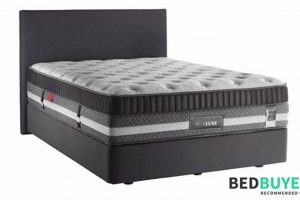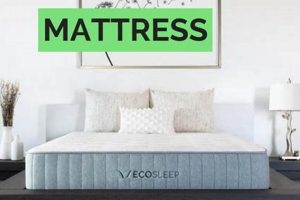The selection of appropriate sleep surfaces significantly impacts spinal alignment and pressure point mitigation, particularly for individuals who favor both dorsal and lateral sleeping positions. The ideal support system should provide adequate contouring for the shoulders and hips when lying on the side, while simultaneously maintaining proper lumbar support when supine. This necessitates a balance between conforming comfort and underlying firmness.
Optimal sleep quality is inextricably linked to musculoskeletal health. A carefully chosen sleep surface can alleviate existing back pain and prevent the development of new discomfort. Historically, advancements in material science and engineering have led to a proliferation of mattress types, each promising superior support and comfort. Understanding the nuances of these options is crucial for informed decision-making.
The subsequent sections will delve into the key characteristics of mattresses suitable for individuals who alternate between back and side sleeping. Factors such as material composition, firmness levels, and construction techniques will be examined to provide a comprehensive understanding of how to identify a product that promotes healthy sleep posture and minimizes discomfort.
Selection Guidance
This section provides guidance on selecting a mattress optimized for individuals who primarily sleep on their back and side.
Tip 1: Prioritize Hybrid Construction: Mattresses combining inner springs with memory foam or latex layers offer a balance of support and pressure relief, accommodating both sleeping positions effectively.
Tip 2: Evaluate Firmness Level: A medium-firm mattress is generally suitable, providing sufficient support for back sleeping and enough give for side sleeping to prevent shoulder and hip pressure.
Tip 3: Consider Zoned Support: Mattresses with zoned support feature varied firmness levels across different areas, offering targeted support to the lumbar region while allowing for greater contouring in the shoulder and hip areas.
Tip 4: Research Material Density: Higher density foams generally provide greater durability and support, ensuring the mattress maintains its structural integrity over time.
Tip 5: Assess Edge Support: Strong edge support prevents roll-off and maximizes the usable sleep surface, particularly beneficial for couples sharing a mattress.
Tip 6: Read Customer Reviews: Examine reviews from individuals with similar sleeping preferences to gain insights into real-world performance and potential drawbacks.
Tip 7: Take Advantage of Trial Periods: Many mattress companies offer trial periods, allowing individuals to test the mattress at home and return it if it does not meet their needs.
Implementing these strategies can significantly enhance the likelihood of selecting a mattress that promotes spinal alignment, reduces pressure points, and improves overall sleep quality.
The subsequent section will summarize the key considerations and offer a final perspective on optimizing the sleep environment for back and side sleepers.
1. Spinal Alignment
Maintaining proper spinal alignment during sleep is paramount for preventing back pain, reducing muscle strain, and promoting overall musculoskeletal health. The selection of a sleep surface significantly influences the ability to achieve and sustain this alignment, particularly for individuals who alternate between supine and lateral sleeping positions.
- Neutral Spine Position
A neutral spine maintains the natural curvature of the spine without excessive flexion or extension. When lying on one’s back, the mattress should support the lumbar region, preventing the hips from sinking too low. When on one’s side, the mattress should allow the shoulder and hip to sink in slightly, maintaining a straight line from head to tailbone. A mattress failing to provide adequate support in either position can lead to spinal misalignment and subsequent discomfort.
- Pressure Distribution
Effective spinal alignment is inextricably linked to balanced pressure distribution. A mattress should evenly distribute body weight, minimizing pressure points that can cause pain and discomfort. When lying on one’s side, excessive pressure on the shoulder and hip can impede circulation and disrupt sleep. A mattress that properly conforms to the body’s contours promotes even pressure distribution, thereby supporting spinal alignment.
- Influence of Mattress Firmness
Mattress firmness plays a critical role in spinal alignment. A surface that is too soft will allow the body to sink too deeply, leading to spinal curvature. Conversely, a surface that is too firm will not conform to the body’s contours, creating pressure points and preventing proper alignment. A medium-firm mattress is often recommended for back and side sleepers as it provides a balance of support and comfort.
- Long-Term Musculoskeletal Health
Sustained spinal misalignment during sleep can contribute to chronic back pain, stiffness, and other musculoskeletal issues. Selecting a mattress that promotes proper alignment is therefore a long-term investment in physical health and well-being. Regular assessment of sleep posture and adjustments to the sleep environment, including mattress selection, can help to prevent these issues.
The interconnectedness of these elements highlights the importance of selecting a mattress specifically designed to accommodate the needs of back and side sleepers. By prioritizing spinal alignment, individuals can significantly improve their sleep quality and reduce their risk of developing musculoskeletal problems.
2. Pressure Point Relief
Pressure point relief is a crucial attribute for optimal sleep quality, particularly for individuals who sleep on their back and side. A mattress that effectively alleviates pressure prevents discomfort, promotes healthy circulation, and minimizes sleep disruptions.
- Contouring and Conformity
Mattresses designed for pressure point relief often incorporate materials such as memory foam or latex, known for their ability to contour to the body’s unique shape. This conformity distributes weight evenly, reducing concentrated pressure on areas like the shoulders, hips, and spine. Inadequate contouring can lead to restricted blood flow and the need to shift positions frequently throughout the night, disrupting sleep cycles.
- Material Density and Responsiveness
The density of mattress materials influences their ability to provide both support and pressure relief. High-density memory foam, for example, offers superior support and conforming properties compare
d to lower-density alternatives. Responsiveness refers to how quickly the mattress adapts to changes in pressure. A responsive material quickly adjusts as one shifts positions, maintaining consistent pressure relief. - Zoned Support Systems
Some mattresses incorporate zoned support systems, which feature varying levels of firmness in different areas of the mattress. These systems are specifically designed to provide targeted support to heavier areas of the body, such as the hips, while allowing for greater give in areas that require more pressure relief, such as the shoulders. Zoned support is particularly beneficial for side sleepers, who experience increased pressure on the shoulder and hip joints.
- Impact on Sleep Quality
Effective pressure point relief contributes directly to improved sleep quality. By minimizing discomfort and promoting healthy circulation, a mattress that alleviates pressure allows individuals to fall asleep faster, experience fewer sleep interruptions, and wake up feeling more rested. The long-term benefits of consistent pressure relief include reduced risk of chronic pain and improved overall well-being.
The selection of a mattress prioritizing pressure point relief is essential for individuals who seek a restorative sleep experience and aim to minimize musculoskeletal discomfort. By considering factors such as material composition, density, responsiveness, and zoned support systems, consumers can make informed decisions that positively impact their sleep quality and overall health.
3. Material Composition
The material composition of a mattress directly influences its suitability for back and side sleepers. Different materials offer varying degrees of support, contouring, and temperature regulation, each impacting spinal alignment and pressure point relief. For instance, memory foam conforms closely to the body, providing substantial pressure relief, but can retain heat. Latex offers a balance of support and responsiveness, with natural breathability. Innerspring systems provide robust support, but may lack the conforming properties necessary for side sleeping. The ideal mattress often combines these materials to leverage their respective strengths.
Hybrid mattresses, which integrate innerspring cores with layers of memory foam, latex, or polyfoam, exemplify this principle. The innerspring unit furnishes foundational support for back sleepers, maintaining spinal alignment. The comfort layers contour to the body when side sleeping, alleviating pressure on the shoulders and hips. The specific arrangement and density of these layers determine the overall feel and performance of the mattress. Certifications such as CertiPUR-US ensure that foams meet standards for content, emissions, and durability, affecting both health and longevity.
Ultimately, selecting a mattress requires a nuanced understanding of material properties and their interaction. Material composition dictates the key performance characteristics that determine whether a mattress effectively caters to the unique needs of individuals who sleep on their back and side. Proper material selection promotes spinal alignment, minimizes pressure points, and supports restorative sleep, therefore significantly influencing long-term musculoskeletal health.
4. Firmness Level
Firmness level exerts a critical influence on the effectiveness of a mattress, particularly for those who alternate between back and side sleeping positions. It directly affects spinal alignment and pressure point distribution, determining the degree to which the mattress supports the body in each position. A firmness level that is either too soft or too firm can lead to misalignment, discomfort, and ultimately, disrupted sleep. Thus, appropriate firmness is essential for a mattress to qualify as a leading choice for these sleepers.
For example, a mattress that is excessively soft may cause the hips to sink too deeply when lying on the back, resulting in spinal curvature and lower back pain. Conversely, when lying on the side, the shoulders may not be adequately accommodated, leading to pressure buildup and discomfort. Conversely, a mattress that is too firm may provide insufficient contouring for the side sleeping position, resulting in pressure on the shoulders and hips. The ideal firmness for these sleepers typically falls within the medium to medium-firm range, providing adequate support for the back while allowing sufficient give for the side. However, individual preferences and body weight should also be considered.
In conclusion, firmness level constitutes a crucial element in identifying a mattress that effectively caters to the needs of back and side sleepers. Understanding the impact of firmness on spinal alignment and pressure distribution allows consumers to make informed decisions that promote optimal sleep quality and musculoskeletal health. While general guidelines exist, individual factors such as body weight and personal preference necessitate careful consideration to achieve optimal comfort and support.
5. Edge Support
Edge support significantly influences the overall usability and comfort of a mattress, particularly for individuals who favor both back and side sleeping positions. A robust edge prevents roll-off, expands the usable sleep surface, and facilitates ease of entry and exit from the bed. Its absence can negate other advantageous features, diminishing the perceived value of a mattress.
- Expanded Sleep Surface
Reinforced edges maximize the available sleeping area. Individuals, especially couples, often utilize the full width of the mattress. Without adequate edge support, the perimeter collapses under pressure, leading to a sensation of instability and reducing the usable area. A firm edge allows sleepers to comfortably position themselves near the periphery without fear of rolling off.
- Ease of Entry and Exit
Strong edges provide a stable surface for sitting on the side of the bed. This is particularly relevant for individuals with mobility limitations or those who frequently sit on the edge to dress or perform other activities. A collapsing edge can create an unstable and potentially hazardous situation, increasing the risk of falls.
- Structural Integrity and Longevity
Well-constructed edge support contributes to the overall structural integrity of the mattress. By reinforcing the perimeter, edge support prevents sagging and maintains the shape of the mattress over time. Mattresses lacking adequate edge support are more prone to deformation, reducing their lifespan and diminishing their support capabilities.
- Enhanced Support for Side Sleepers
Side sleepers often concentrate their weight on a smaller surface area. Strong edges help maintain even support across the entire mattress surface, preventing excessive sinking along the perimeter. This contributes to improved spinal alignment and reduces pressure points on the shoulders and hips for individuals who favor lateral sleeping positions.
The presence of robust edge support enhances the practicality and comfort of mattresses selected by back and sid
e sleepers. It augments usable space, facilitates ease of movement, reinforces long-term durability, and provides consistent support across the entire sleep surface, rendering it a critical factor in overall mattress quality. Mattresses lacking adequate edge reinforcement may compromise spinal alignment and usable space, undermining the benefits of other design features.
6. Temperature Regulation
Temperature regulation constitutes a critical performance characteristic for any sleep surface, with particular relevance to individuals favoring both back and side sleeping positions. Body temperature naturally fluctuates during sleep cycles, and a mattress’s ability to dissipate heat and promote airflow directly influences sleep quality and comfort. Inadequate temperature regulation can lead to overheating, restlessness, and disrupted sleep patterns, negating the benefits of proper spinal alignment and pressure point relief. Conversely, a mattress that effectively manages temperature facilitates a more stable and restorative sleep experience.
The materials comprising a mattress exert a significant influence on its thermal properties. Memory foam, while known for its conforming properties, can retain heat due to its dense structure. Latex, particularly natural latex, typically offers superior breathability, promoting airflow and reducing heat buildup. Innerspring systems, by their design, allow for greater air circulation compared to solid foam cores. Incorporating breathable fabrics such as cotton or Tencel in the mattress cover further enhances temperature regulation. For example, individuals residing in warmer climates or those prone to night sweats may benefit significantly from mattresses constructed with latex or innerspring systems, coupled with breathable cover materials. In contrast, those in colder climates may find memory foam more suitable, provided measures are taken to mitigate heat retention.
Effective temperature regulation is a fundamental component of a sleep surface conducive to both back and side sleeping. It complements the crucial aspects of spinal alignment and pressure relief, culminating in a sleep environment that promotes physical restoration and overall well-being. While material selection is paramount, factors such as room temperature, bedding choices, and individual physiological characteristics also contribute to the overall thermal experience. Addressing temperature regulation ensures that the inherent benefits of optimal support and contouring are not compromised by thermal discomfort, leading to a truly effective sleep solution.
7. Durability
The longevity of a mattress directly impacts its value and long-term performance, particularly for individuals who favor both back and side sleeping positions. A durable mattress maintains its structural integrity and support characteristics over time, preventing sagging, indentation, and loss of firmness. These deteriorations compromise spinal alignment and pressure point relief, undermining the initial benefits experienced with a new mattress. For example, a memory foam mattress that develops significant body impressions will no longer provide the contouring necessary for comfortable side sleeping, while a deteriorating innerspring system will fail to support the lumbar region for back sleepers. Therefore, durability constitutes a fundamental component of a mattress deemed suitable for this sleep preference.
Factors contributing to mattress durability include material quality, construction techniques, and usage patterns. High-density foams, robust innerspring systems, and reinforced edge support enhance resistance to wear and tear. Proper maintenance, such as regular rotation and the use of a mattress protector, can also extend lifespan. In contrast, lower-quality materials, inadequate construction, and excessive weight can accelerate deterioration. For instance, a mattress with a low-density foam comfort layer is more likely to break down prematurely compared to one utilizing high-density foam. The choice of materials and construction methods has a direct, measurable impact on the long-term cost-effectiveness and performance of the mattress.
In summary, durability is not merely a desirable attribute but a necessary condition for a mattress that consistently meets the needs of back and side sleepers. Its influence spans spinal alignment, pressure point relief, and overall comfort. Selecting a mattress constructed with durable materials and employing sound engineering principles represents an investment in long-term sleep quality and musculoskeletal health. The trade-off for a initially cheaper, less durable mattress is a higher long-term cost in terms of both money and quality of sleep, ultimately making durability a core consideration in identifying a suitable sleep surface.
Frequently Asked Questions
The following addresses common inquiries concerning the selection of mattresses optimized for individuals who primarily sleep on their back and side.
Question 1: What firmness level is generally recommended for back and side sleepers?
A medium-firm mattress is generally recommended, providing adequate support for back sleeping while offering sufficient give for side sleeping to prevent excessive pressure on the shoulders and hips. Specific firmness preferences may vary based on individual body weight and personal comfort considerations.
Question 2: Are hybrid mattresses suitable for individuals who sleep on their back and side?
Hybrid mattresses, which combine innerspring systems with layers of memory foam or latex, can be particularly well-suited. The innerspring core provides foundational support, while the comfort layers offer pressure relief and contouring for enhanced comfort in both sleeping positions.
Question 3: How important is edge support for back and side sleepers?
Edge support is a significant factor, particularly for couples or individuals who tend to sleep near the edge of the mattress. Robust edge support prevents roll-off, maximizes the usable sleep surface, and facilitates ease of entry and exit from the bed. Insufficient edge support can compromise spinal alignment and overall comfort.
Question 4: What role does material composition play in selecting a suitable mattress?
Material composition directly influences the mattress’s support, contouring, temperature regulation, and durability. Different materials, such as memory foam, latex, and innerspring coils, offer unique performance characteristics. A thorough understanding of these characteristics is crucial for informed decision-making.
Question 5: Is temperature regulation a significant consideration for back and side sleepers?
Temperature regulation is a critical factor for overall sleep comfort. Mattresses that effectively dissipate heat and promote airflow can prevent overheating and restlessness, contributing to a more stable and restorative sleep experience. Individuals prone to night sweats should prioritize mattresses with enhanced breathability.
Question 6: How does durability influence the long-term value of a mattress?
The durability of a mattress directly affects its long-term value and performance. A durable mattress maintains its structural integrity and support characteristics over time, preventing sagging and loss of firmness. Selecting a
mattress constructed with high-quality materials and robust construction techniques represents an investment in long-term sleep quality.
In summary, effective mattress selection for individuals who sleep on their back and side requires careful consideration of firmness level, construction type, edge support, material composition, temperature regulation, and durability. Addressing these factors can significantly enhance sleep quality and overall musculoskeletal health.
The subsequent section will provide closing remarks, synthesizing the information presented and emphasizing the importance of personalized mattress selection.
Conclusion
The foregoing analysis underscores the complexities inherent in selecting a sleep surface that effectively caters to the dual needs of back and side sleepers. Firmness level, material composition, edge support, temperature regulation, and durability emerge as critical, interconnected factors. While generalized recommendations can provide initial guidance, the ultimate selection necessitates a thorough understanding of individual physiological characteristics, sleeping habits, and personal preferences. Ignoring these nuances can lead to suboptimal sleep quality and potential musculoskeletal complications. The determination of the best mattress for back and side sleepers is therefore a highly individualized process.
The pursuit of optimal sleep should be approached with diligence and informed consideration. Investing time in research, critically evaluating product specifications, and taking advantage of available trial periods are essential steps. The impact of a well-chosen sleep surface extends beyond immediate comfort; it constitutes a fundamental investment in long-term health and well-being. Continued advancements in material science and sleep technology offer the potential for even more personalized and effective sleep solutions, underscoring the ongoing importance of staying informed and proactive in optimizing the sleep environment.


![Top-Rated: Choosing the Best Mattress Foundation [Guide] Organic & Natural Mattress Buyer’s Guide: Non-Toxic Sleep Solutions Top-Rated: Choosing the Best Mattress Foundation [Guide] | Organic & Natural Mattress Buyer’s Guide: Non-Toxic Sleep Solutions](https://mattressworldpa.com/wp-content/uploads/2025/07/th-7633-300x200.jpg)




![How to Find the Best Way Twin Air Mattress [Guide] Organic & Natural Mattress Buyer’s Guide: Non-Toxic Sleep Solutions How to Find the Best Way Twin Air Mattress [Guide] | Organic & Natural Mattress Buyer’s Guide: Non-Toxic Sleep Solutions](https://mattressworldpa.com/wp-content/uploads/2025/07/th-7628-300x200.jpg)